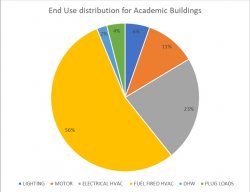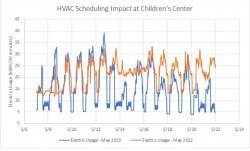Benefits of HVAC Scheduling
Posted in: Sustainability

Heating, Ventilation, and Air Conditioning (HVAC) systems are crucial components of modern buildings, providing comfort and maintaining indoor air quality. However, running HVAC systems continuously can lead to unnecessary energy consumption and increased operational costs. HVAC scheduling, a strategic approach to programming the HVAC operation to better align equipment usage with the building usage.
HVAC systems are among the largest energy consumers in buildings, accounting for 75% of a building’s total energy usage, see the chart below. Implementing a scheduling strategy allows precise control over when the system operates, ensuring it operates only when needed. By adjusting temperature settings or turning off the system during unoccupied hours, energy consumption is significantly reduced. This leads to lower utility bills and a noticeable reduction in energy expenses. At Montclair we currently run the majority of our HVAC with little to no scheduling setbacks.

Constantly running HVAC systems can lead to additional wear and tear, shortening their lifespan and increasing maintenance costs. Scheduling allows for periods of rest, reducing the strain on equipment and promoting longevity. This leads to fewer breakdowns and the need for fewer repairs, saving both time and money.
HVAC scheduling doesn’t necessarily mean sacrificing comfort. By intelligently setting up schedules based on occupancy patterns, occupants can enjoy a comfortable environment during their working or living hours. Maintaining optimal indoor conditions enhances occupant satisfaction and can lead to increased productivity in work and learning environments.
On-site example – Children’s Center
In May 2023 we implemented schedules in the Ben Samuel’s Children Center. The occupied temperatures were left as-is, but unoccupied setbacks were added and an unoccupied schedule was established. We reduced the unoccupied heat temperature by 10° and increased the unoccupied cooling temperature by 4° when the building was empty, nights and weekends. Previously the HVAC was maintaining 72° 24/7. The chart below shows the impact on the electric usage during this month alone.

The blue line represents the electric usage for a two-week period in May 2023, while the orange line is the same period in 2022. The low dips in the blue line are the overnight and weekend times when the HVAC systems was running on the unoccupied schedule, with the difference resulting in energy savings.
The total reduction for one month was 10,257 kWh or 30.2%, which equates to a savings of $1,733/month for one building, during one of the more temperate months of the year. Expanding this initiative across campus can save the university hundreds of thousands of dollars per year.
HVAC scheduling is a smart and proactive approach to optimizing energy consumption, reducing costs, and enhancing both environmental and occupant well-being. By implementing a well-thought-out HVAC scheduling strategy, building owners and managers can create a balance between comfort and efficiency, contributing to a sustainable and comfortable indoor environment.
This relates directly to the Facilities Sustainability Plan Goal 01-3: Reduce campus-wide energy use intensity and annual energy costs.
Learn more about Sustainable Facilities!
